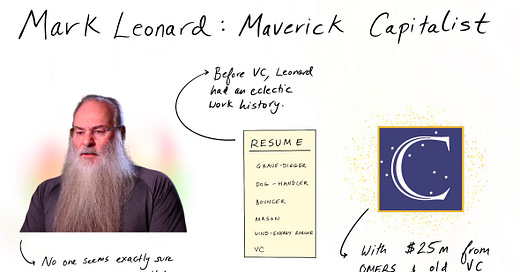As an operator turned impact investor and venture capitalist, I tend to view assets through a business lens, echoing Warren Buffet’s perspective that
“Charlie and I are not stock-pickers; we are business-pickers.”
As VCs, our image is often that of unicorn hunters, chasing those rare, high-valuation startups. However, the economics of traditional venture capital hinge on outliers and diversified portfolios, a strategy that can yield sub-optimal or even mediocre returns. I find myself intrigued by alternative models, such as micro-acquisition funds exemplified by tiny.com and Mark Leonard's approach with Constellation Software.

Constellation, founded by Mark Leonard, has quietly become one of Canada’s most successful tech companies. The company's strategy is to acquire small vertical market software businesses across a diverse range of niches, from transportation management systems to scheduling software for salons. Unlike most acquirers, Constellation does not look to consolidate these companies. Rather, it adopts a decentralized model where the founders and managers stay in control of day-to-day operations even after acquisition. This ensures that product expertise and institutional knowledge are retained.
The decentralized, acquisition-focused nature of Constellation combined with disciplined capital allocation makes its model very similar to Berkshire Hathaway’s, though applied to smaller software businesses rather than entire conglomerates. This patient, cash-flow-focused approach has worked exceptionally well for both companies over the long term.
Tiny applies a similar strategy, targeting profitable bootstrapped SaaS businesses with $750k to $10 million in revenue. These micro-acquisition firms focus on optimizing and scaling niche software companies, rather than swinging for unicorns. The economics can be compelling - by paying 5-7x revenue for these businesses, Constellation and Tiny enjoy 30-50%+ cash flow margins and 30%+ IRRs.
I believe more capital deployers should consider this strategy to create outsized returns as well as impact. These funds acquire and consolidate small and medium-sized businesses that are fit for sub-5 million dollar acquisitions. This strategy, often termed "roll-up" or "buy and build," involves acquiring profitable companies and leveraging synergies to create a larger, more robust entity—an umbrella company that houses all these small companies targeting specific niches.
For investors, particularly operators, micro-acquisition presents a compelling strategy:
Operational Involvement: Micro-acquisition funds often consist of individuals with strong operational backgrounds. Investors involved in these funds are not only financial contributors but also bring practical business experience. This operational expertise is crucial for identifying and maximizing the value of the acquired businesses.
Hands-on: Unlike traditional venture capital models that may have a more passive approach, micro-acquisition funds tend to adopt a hands-on approach. Investors actively participate in the management and strategic decisions of the businesses they acquire, leveraging their expertise to drive operational improvements.
Diversification: To spread risk and create a resilient portfolio, micro-acquisition funds often adopt a diversification strategy. By acquiring businesses in different industries or niches, these funds aim to mitigate the impact of sector-specific challenges and market fluctuations.
Focus on Profitability: The primary objective of micro-acquisition funds is to target small businesses that are already profitable. Unlike some venture capital models that prioritize high-growth potential over immediate profitability, micro-acquisition funds seek businesses with proven revenue streams and a track record of financial stability. Hence, this reduces the risk profile and makes it more predictable.
Long-term Value Creation: The focus is on long-term value creation rather than quick exits. By acquiring businesses with proven track records, micro-acquisition funds aim to enhance and sustain the success of these enterprises over time.
Network Effects and Platform Approach: Investors in micro-acquisition funds often bring a wealth of industry knowledge, experience, and networks. These resources are leveraged to support the growth and development of the acquired businesses.
The patient, business-focused nature of micro-acquisition investing generates steadier, less volatile returns less correlated to VC boom and bust cycles. I think this can be an exciting approach if applied to the world of impact investing and the broader conscious capitalism arena. Also, I see micro-acquisition funds as a type of venture studio that houses predictable small niche-focused businesses under one umbrella.
The lessons learned from Constellation Software and Tiny underscore the potential for outsized returns when businesses are approached with a keen focus on operations, profitability, long-term value, and impact creation. As more capital deployers explore these strategies, we may witness a transformation in the capital allocation landscape toward a more resilient and consciously driven future.
Curated resources for further curiosity:
Mark Leonard (Constellation Software) Story - Billionaire Software Empire Builder:
The Greatest Capital Allocator No One Knows About:
Mark Leonard (Constellation Software) 2020 interview:
#246 Mark Leonard's Shareholder Letters:
Constellation Software: Principled, Profitable, Permanent:
Constellation President's Letters:
https://www.csisoftware.com/category/pres-letters/#Entrepreneurial Insights | Andrew Wilkinson | Knowledge Project 143
#427 Andrew Wilkinson on Why He Buys Certain Companies
Berkshire.com: How Tiny's Andrew Wilkinson is building the Berkshire of the Internet with Tobias
Stay humble, stay curious 🌟🌟🌟!
If you have not subscribed, please do subscribe to keep up to date with my musings on venture capital, venture building, impact investing, conscious capitalism, and fund management.



